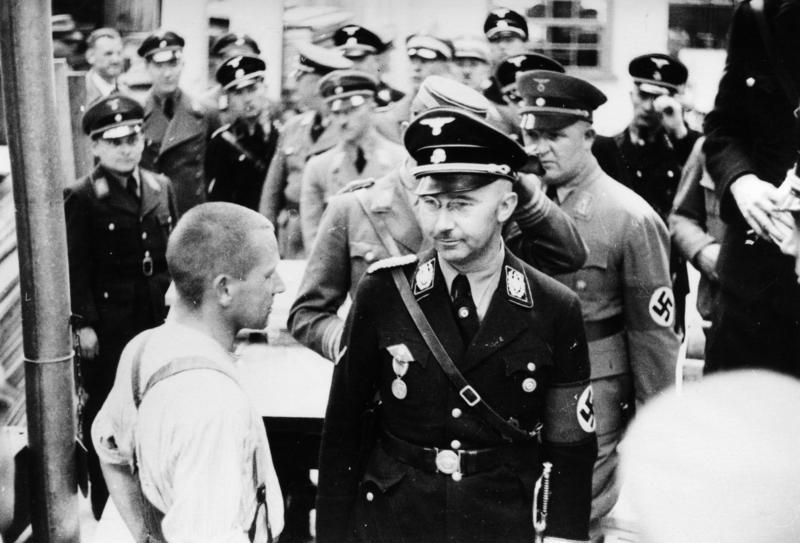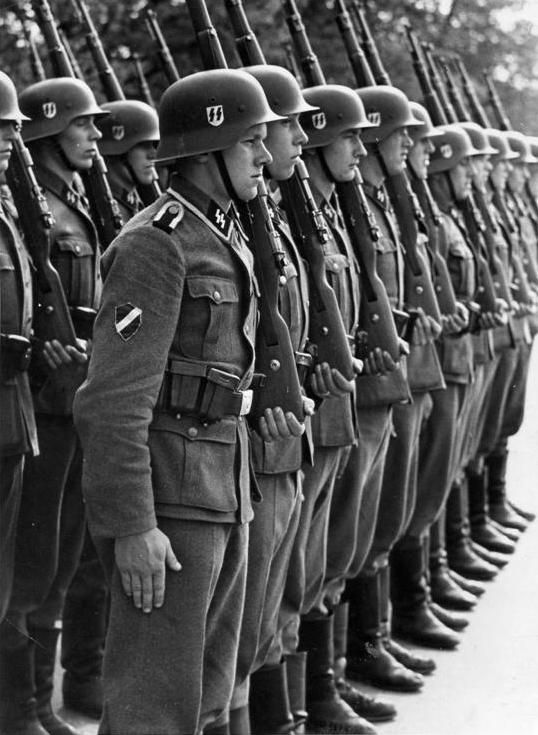The SS was the abbreviated form of the German Schutzstaffel, meaning "protection squadron," which began as a small personal bodyguard for Adolf Hitler and grew into a large multipurpose arm of the Nazi Party by the end of World War II.
In 1925 the Stosstrupp Adolf Hitler was formed as a group of eight men with the task of protecting Adolf Hitler at rallies, speeches, and other events after the failed Beer Hall Putsch
The SS remained a small force for the first few years but expanded rapidly after the appointment of Heinrich Himmler
  |
Admittance to the SS was restricted by race to Germans, and the organization had a special interest in attracting "Aryans," blonde-haired, blue-eyed Germans who were viewed as the vanguard of the Germanic peoples.
Under Himmler and his right-hand man Reinhard Heydrich, the power of the SS grew, and it became a branch of the German government under Adolf Hitler. The SS assumed the role of guards of the Reichschancellery and later expanded into the first Waffen-SS Division.
The Waffen-SS
 |
| SS Uniform |
Shortly after the Nazis came to power, the SS expanded its role in German politics and society. In 1934 the SS took control over the Geheime Staatspolizei (the German secret state police, known as the Gestapo). The Gestapo
Two years later all German federal, state, and local police were absorbed into the SS. The newly established concentration camps came under the control of the SS-Totenkopfverbande (SS Deathshead Unit, or SS-TV).
The SS-TV continued to expand with Nazi conquests, establishing new concentration camps. During the war, disabled WaffenSS veterans often moved into SS-TV units and were sent to work at the concentration camps.
   |
Once Germany began to expand, Einsatzgruppen (special action squads) were formed by the SS on an as-needed basis to neutralize threats to Germany. In 1941, as a precursor to the final solution, the Einsatzgruppen moved into the Soviet Union and began the extermination of Jews, Gypsies, and communists.
The Algemeine-SS, also established in 1934, was responsible for race, security, finance, administration, and personnel. Officers were established to help SS officers who had suffered during the struggle for power. Other offices oversaw party and military awards, press and information, and liaison between Himmler and the Four-Year [economic] Plan.
 |
| SS Soldiers |
Another office controlled the teaching of ancestral heritage, genealogy, and biological research; still another oversaw the welfare of SS mothers and children. Later the Algemeine-SS took on a reserve role, with many of its members serving in other Nazi organizations. The SS Medical Corps provided medical care to SS units in the 1930s.
After the establishment of the concentration camps, the SS Medical Corps began experimentations on human prisoners. The most notorious of these crimes occurred at Auschwitz under the leadership of SS doctor Joseph Mengele
During the war the Algemeine-SS was responsible for executing SS policy in the occupied territories. These were added to the Weimar government records that the Nazis had inherited, making the Nazi regime the most heavily documented government and society in history.
 |
| Inspection by Himler |
Shortly after the Reichstag fire, the Algemeine-SS provided help to the police forces during the roundup and imprisonment of Germany's communists and potential Nazi Party opponents.
The Waffen-SS continued to grow after the outbreak of war and eventually reached 38 divisions. Many were made up of foreign volunteers from occupied Europe. The racial restrictions were relaxed because of a manpower shortage.
Some foreign units ended up defending Berlin and Hitler's bunker during the final Russian offensive. Because of their fanatical loyalty to Hitler and the Nazi Party, SS combat formations were given priority when new equipment and new weapons were issued.
 |
| SS Lituaniens |
They also had priority in receiving replacements to cover casualties. Waffen-SS units were feared by the Allies because of their fanatical indoctrination and cruel treatment of civilians and prisoners.
